May 20, 2025 | 14:21 GMT +7
May 20, 2025 | 14:21 GMT +7
Hotline: 0913.378.918
May 20, 2025 | 14:21 GMT +7
Hotline: 0913.378.918
Dr. Tran Thi Lien is a delegate of the Department of Traditional Medicine and Pharmacy under the Ministry of Health to Binh Dinh province to perform inspection and evaluatation regarding “Good Agricultural and Collection Practices of medicinal plants in accordance with the World Health Organization (GACP-WHO); namely at Binh Dinh Pharmaceutical-Medical Equipment Joint Stock Company (BIDIPHAR) in An Lao district. Dr. Tran Thi Lien, currently the Deputy Head of the Medicinal Seed Department of Hanoi Center for Research and Processing of Medicinal Plants under the Institute of Medicinal Plants, affirmed that the land is full of potential for the development of medicinal plants, with special focus in An Toan upland commune, where there is a large area of primary forest.
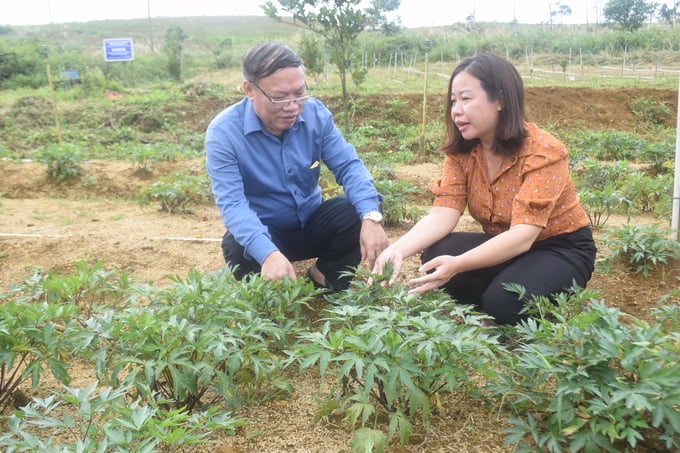
Dr. Tran Thi Lien and Mr. Nguyen Van Khang, Head of Traditional Medicine and Pharmacy Practice Management Department under Department of Traditional Medicine and Pharmacy, perfoming inspection of BIDIPHAR's traditional dong quai farm in An Toan commune, An Lao district, Binh Dinh. Photo: V.D.T.
The delegation was impressed by the various green and lush medicinal plants including dong quai, Ampelopsis cantoniensis, Solanum procumbens, Gymnema Sylvestre, Polygonum multiflorum, indian mulberry, Vietnamese ginseng, Chinese ginseng, etc. collected from BIDIPHAR's farms and other upland, forest canopy areas belonging to the Bana people in An Toan commune.
According to Dr. Tran Thi Lien, the Department of Traditional Medicine and Pharmacy returned to Binh Dinh to evaluate and maintain the standards of medicinal plants for: dong quai, Ampelopsis cantoniensis, Solanum procumbens, Gymnema Sylvestre according to the criteria set by GACP-WHO. The evaluation of medicinal plant areas under the GACP-WHO criteria helps to trace the origin as well as control the input of medicinal herbs. Pharmaceuticals produced from medicinal plants that are certified under the "Good Agricultural and Collection Practices by WHO" will be favored by consumers thanks to their clear origin; the pharmaceuticals can also easily participate in auctions to supply to hospitals.
“Upon inspection, we found that BIDIPHAR excels at organizing production, the medicinal farms are invested methodically. Namely, the medicinal farms are equipped with semi-automatic irrigation systems, the ground is covered with rice husks to retain moisture as well as loosen the soil. The company also carefully controls the selection of quality seeds before planting; the process of preliminary processing and processing of pharmaceutical products is secured”, shared Dr. Tran Thi Lien.
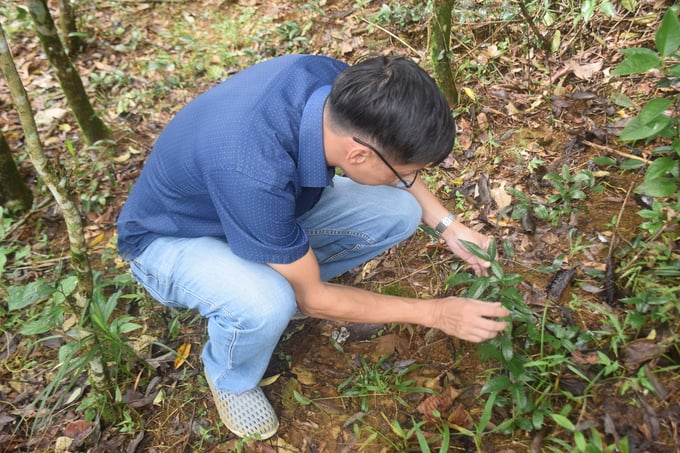
Purple Indian mulberry planted under the forest canopy in An Toan commune, An Lao district, Binh Dinh. Photo: V.D.T
According to Mr. Nguyen Duc Thiep, Head of BIDIPHAR's Medicinal Project Management Board, the company has recently deployed organic medicinal plant production in compliance with GACP-WHO criteria. There are 4 types of medicinal plants certified by the Department of Traditional Medicine and Pharmacy as "Good Agricultural and Collection Practices by WHO" in 2018. During this inspection, the plants were evaluated to have maintained their standards.
The GACP-WHO criteria requires BIDIPHAR to issue instructions on specific operations for all officers and employees as well as organize training for workers. During the production process, the company's technical staff accompanied employees to promptly identify and rectify mistakes.
According to Mr. Thiep, in order to develop medicinal plants as guided by the Binh Dinh Provincial People's Committee, BIDIPHAR invested in the project of growing medicinal plants according to GACP-WHO in 2016. Binh Dinh Provincial People's Committee allowed BIDIPHAR to use an area of nearly 760,000m2 in An Lao district for medicinal plants.
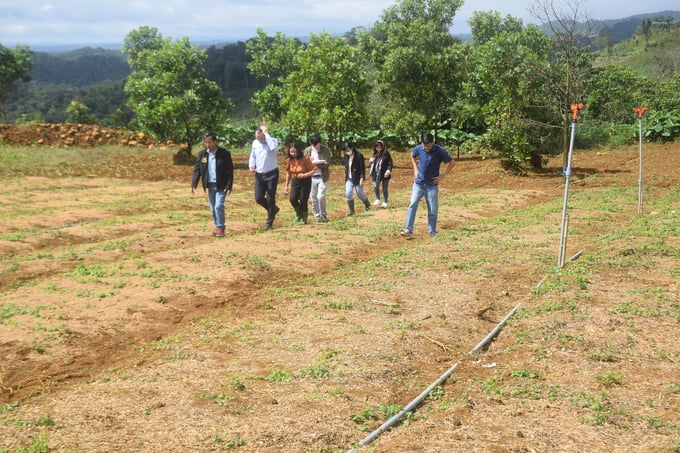
The delegation of the Department of Traditional Medicine and Pharmacy under the Ministry of Health perfomring inspection of BIDIPHAR's Vietnamese ginseng growing area in An Toan commune, An Lao district, Binh Dinh. Photo: V.D.T
“BIDIPHAR is currently growing 12 types of medicinal plants, 4 of which have been certified under the "Good Agricultural and Collection Practices" criteria by the Department of Traditional Medicine and Pharmacy including: dong quai, Ampelopsis cantoniensis, Solanum procumbens, Gymnema Sylvestre. The company has submitted applications for the evaluation of 4 additional medicinal plants: Polygonum multiflorum, indian mulberry, Vietnamese ginseng, Chinese ginseng; the application has been approved by the Department of Traditional Medicine and Pharmacy", said Mr. Nguyen Duc Thiep.
According to Mr. Nguyen Duc Thiep, among the 4 BIDIPHAR plants certified by The Department of Traditional Medicine and Pharmacy for "Good Agricultural and Collection Practices", the technical process has been transferred to 6 Bana-ethnic households in 3 hamlets in An Toan commune, An Lao district; the plants are grown on swidden land and under the forest canopy with an area of 21,000m2, with the smallest household growing 2,000m2, and the largest growing 5,000m2.
“Farmers have harvested the first batch of medicinal plants after 8 months. Each household harvested from 280 to 300kg on average; BIDIPHAR buys them for 10,000 VND/kg, and the farmers are thrilled. The next batch of medicinal plant production will certainly be higher. In the roadmap for the development of medicinal plants in An Lao, Ampelopsis cantoniensis is a pioneering step in familiarizing the Bana people with planting, nurturing and collecting medicinal plants in accordance with the GACP-WHO criteria. Subsequently, BIDIPHAR will expand to add several other medicinal plants that are effective in medical treatment with high economic value, and widen output such as Kaempferia galanga and Ligusticum striatum", explained Mr. Nguyen Duc Thiep.
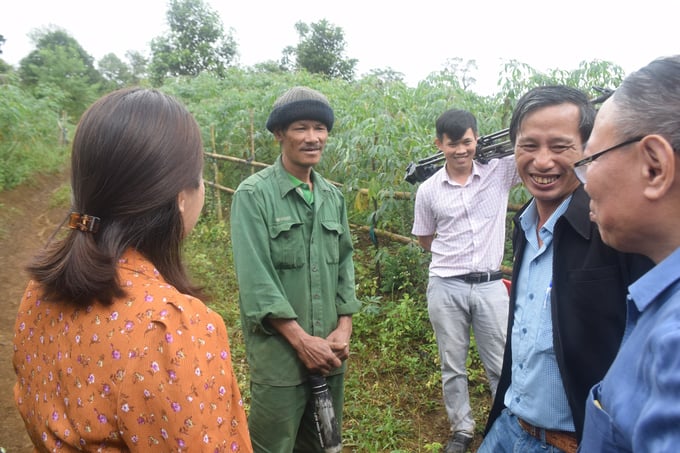
Farmer Dinh Van Trac (center), a Bana-ethnic person in An Toan commune, An Lao district, Binh Dinh participating in medicinal plants production, interviewed by the delegation. Photo: V.D.T
According to Dr. Tran Thi Lien, Deputy, An Lao District, especially the An Toan highland commune, is highly favorable in terms of natural climate. As a result, medicinal plants develop extremely well, on par with many medicinal plant regions in the North.
Dr. Lien assessed Dong quai as a medicinal plant that is highly suitable for the natural conditions in An Toan commune. The medicinal substance in the tubers reaches its highest potency after 12 months of growing. If the growth cycle of dong quai is extended to 12-18 months, the yield will be higher, and the economic value will increase accordingly.
Furthermore, Dr. Lien believes that dong quai seeds must be obtained from cold climates, and they must be collected from plants that have been grown for at leaset 2 to 3 yearsfor a higher quality, otherwise, the plants will flower simultaneously. If the dong quai blooms, the yield will be very poor. This is due to the fact that the nutrients have been shared to feed the flowers, leaving less nutrients for the bulbs.
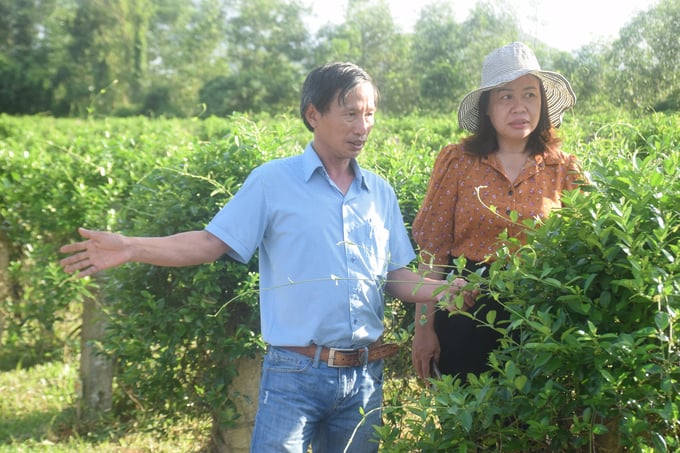
The delegation performing inspection of the Gymnema Sylvestre growing area in An Tan commune, An Lao district, Binh Dinh. Photo: V.D.T
On the other hand, ginseng has a relatively high economic value. Dried ginseng is currently sold at the price point of 750,000 VND for a kilogram. When the plant reaches 20 to 30cm in height, the farmer needs to make a truss for the plant to climb, and the plant will grow even more vigorously. The growth cycle of ginseng lasts for 24 to 30 months until harvest, and thanks to its high price, the economic efficiency is excellent. The Ganoderma Lucidum, which sells for 1.5 million VND/kg at peak times, is another suitable plant to grow under the forest canopy.
“Regarding tubers, the company should advise the farmers to choose the appropriate season to sow directly into the soil, to save labor in transporting seeds from the nursery to the planting area. The straight sowing method helps the plants grow stronger as well as avoid loosening the roots of seedlings when transporting, which will affect the survival rate of plants when planted. An Lao commune has many primary forests, so it is possible to grow medicinal plants under the forest canopy, especially indigenous plants with a harvest cycle of 2 to 3 years, so that farmers can save labor costs such as indian mulberry, Stephania Erecta, Polygonum multiflorum, cypress tree, bay leaf, among many other suggestions", Dr. Tran Thi Lien recommended.
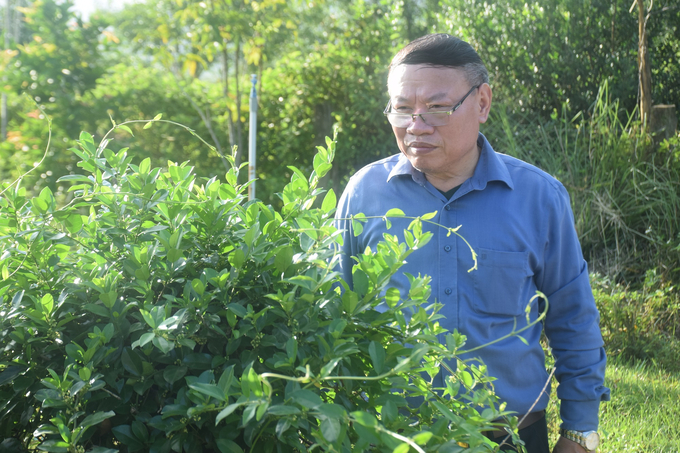
Dr. Nguyen Van Khang affirmed that An Lao district has great potential to develop medicinal plants. Photo: V.D.T
Dr. Lien shared, if An Lao commune focuses on the development of medicinal plants, ethnic minorities in highland communes will have the opportunity to eliminate hunger and reduce poverty, because medicinal plants will consistently bring higher economic benefits compared to other agricultural products.
“Vietnam has to import many types of medicinal herbs, this is rather restricting. For example, during the outbreak of the Covid-19 pandemic, the source of imported medicinal plants was interrupted due to trade restrictions. It's time for us to build medicinal plants growing areas following the GACP-WHO criteria so that pharmaceutical processing businesses can be proactive in terms of raw material source, and farmers can increase their income", commented Dr. Lien.
Translated by Nguyen Hai Long
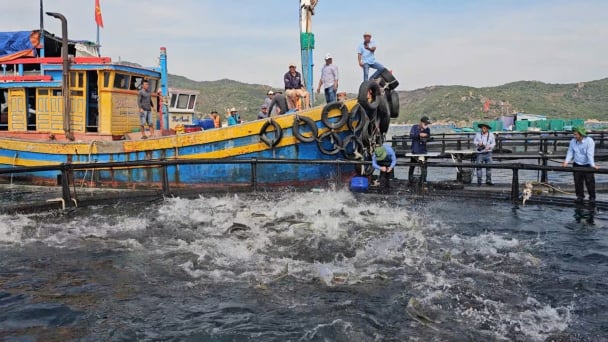
(VAN) Khanh Hoa is investing over 545 billion VND to develop 240 hectares of high-tech marine aquaculture in order to guarantee a consistent supply of seafood exports and achieve the USD 1 billion target.
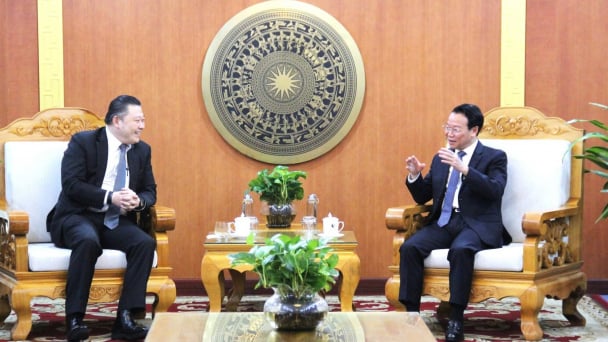
(VAN) Minister of Agriculture and Environment Do Duc Duy held a meeting with Soopakij Chearavanont, Chairman of C.P. Group, on May 15.
/2025/05/16/3800-0-nongnghiep-143756.jpg)
(VAN) Suntory PepsiCo Vietnam coordinated with the Ministry of Education and Training to implement an education program on water conservation, reaching nearly 1 million primary school students nationwide.
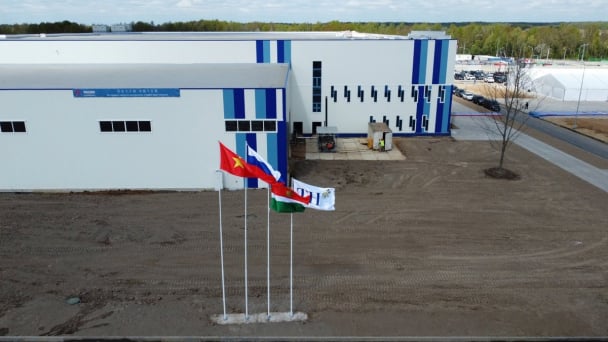
(VAN) Vietnam’s TH Group officially put its high-tech fresh milk processing plant into operation in the Russian Federation, marking a historic moment as the first TH true MILK cartons were produced in Russia.
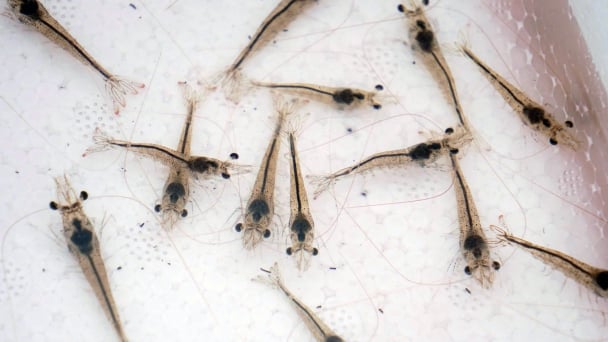
(VAN) Use of high-quality broodstock and biotechnology is regarded as the most effective approach to ensuring sustainable and economically viable shrimp aquaculture ahead of climate change and the emergence of increasingly intricate disease patterns.
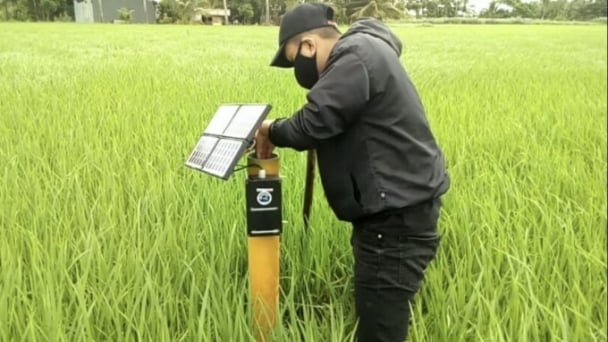
(VAN) Carbon farming is a form of agricultural practices that helps absorb more greenhouse gases than it emits, through smart management of soil, crops, and livestock.
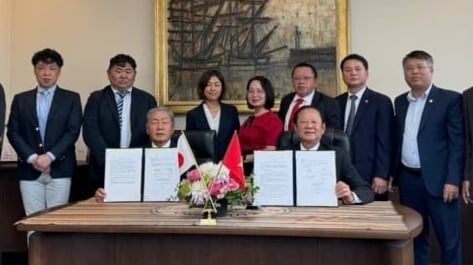
(VAN) This is a key content of the Memorandum of Understanding recently signed between the Vietnam Fisheries Society and Kunihiro Inc of Japan.